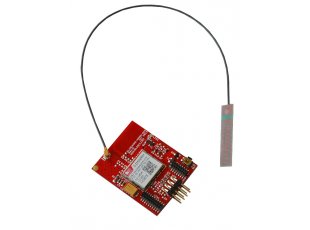≡



OLIMEXINO-NANO-GSM



GSM/GPRS/Bluetooth 3.0 shield for OLIMEXINO-NANO with SIM800H quad band module
| Price | 15.00 EUR |
|---|---|
| 10 - 49 pcs | 13.50 EUR |
| 50 - 10000 pcs | 12.00 EUR |
OLIMEXINO-NANO-GSM is a GSM/GPRS/Bluetooth 3.0 shield for OLIMEXINO-NANO with the SIM800H quad band module. It allows OLIMEXINO-NANO to perform GSM data calls (act as GSM modem), to send and receive SMS and to send and receive GPRS data and to connect to Bluetooth 3.x devices. This module has an external antenna connector for the 3.0+EDR GSM and PCB antenna.
FEATURES
- Comes with external antenna with standard U.FL connector
- Can be used with OLIMEXINO-NANO and OLIMEXINO-NANO-BAT or stand alone
- Quad band 850/900/1800/1900MHz
- GPRS class 2/10
- Bluetooth 3.0+EDR
- FN: 76-109Mhz radio
- Control via AT commands (3GPP TS 27.007, 27.005 and SIMCOM enhanced AT commandset)
- Supply voltage (3.4 - 4.4)V
- Low power
- Operating temperature: (-40 to +85)C
- PCB size: (1.8 x 1.4)" ~ (4.6 x 3.6)cm
DOCUMENTS
FAQ
- It seems that I can't power the GSM shield via OLIMEXINO-NANO using the microUSB connector. What do I do wrong?
- OLIMEXINO-NANO and OLIMEXINO-NANO-GSM can NOT be properly powered only from the microUSB. It is recommended to use OLIMEXINO-NANO-BAT and a battery. Another option is to provide DC voltage to VBAT2 line (and GND to any digital GND of the board) and the board would be powered. The DC voltage should be in the (3.8-4.2)V range. Providing more than 4.2 volts might cause hardware damage.
It is possible to power the whole setup only via VBAT2 line (it is accessible at either pin #1 of the 4-pin 0.1" header at the bottom of the board - the bottom side is the one with the SIM holder - or, alternatively, at pin #6 of connector CON1).
- I can't run the example. What are the chances that my board is broken?
- Tiny. The board had been tested mutliple times during production. Check if your SIM card has a PIN code enabled. If it has please remove it. You can do that using a regular mobile phone. You can also check if the SIM card registers to the network fine using a regular mobile phone. Other than that check if the powering is as requested. Don't skip the battery. The current spikes (surges) are really high (up to 2A) and fast (milliseconds). Without a battery high current draws like that might lead to shut-downs or restarts of the GSM module or the whole setup even if you have very good main power supply.
- What interfaces (profiles) does the Bluetooth component of SIM800H support?
- Upon successful Bluetooth connection the following interfaces become available: serial port; object push; advanced audio; headset and microphone.
- OLIMEXINO-NANO-GSM module seems to lack some of the software features of other SIM800H modules I have used. What could possibly be the reason?
- The manufacturer of SIM800H is frequently updating the firmware to provide better experience for the end customer. It is possible that the SIM800H of your board has older firmware installed. The good news is that you can update the firmware relatively easy. All you need is a serial cable and then follow the instructions here: GitHub location
- I powered the module but I'm not sure if it works. How can I determine that it works?
- To turn on the unit you would need need to press and hold the PWRKEY for a few seconds. The green LED should turn on and start blinking rapidly. The green LED also indicates the status of the communication with the GSM network – after the initial few seconds it begins to blink at a much slower pace – this means that the communication with the GSM network is ok; alternatively if the LED stops blinking – there is a problem with the network (most likely improper network settings). If it works fine but no communication over the RX and TX - make sure to try to swap the cables, sometimes it is possible to swap RX and TX.
- What interfaces (profiles) does the Bluetooth component of SIM800H support?
- Upon successful Bluetooth connection the following interfaces become available: serial port; object push; advanced audio; headset and microphone.




